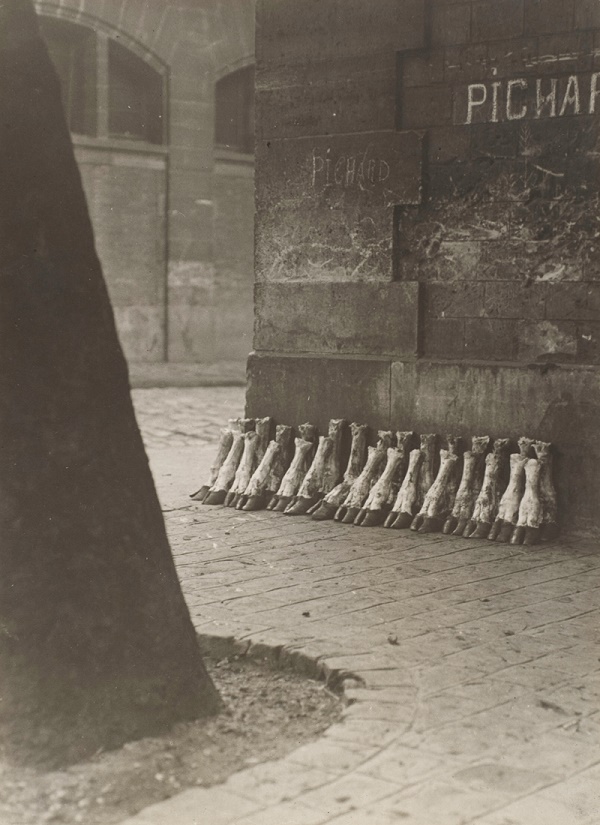
Eli Lotar, Aux Abattoirs de La Villette [At La Villette’s Slaughterhouses], 1929, coll. Metropolitan Museum, NYC

Eli Lotar, Aux Abattoirs de La Villette [At La Villette’s Slaughterhouses], 1929, coll. Metropolitan Museum, NYC
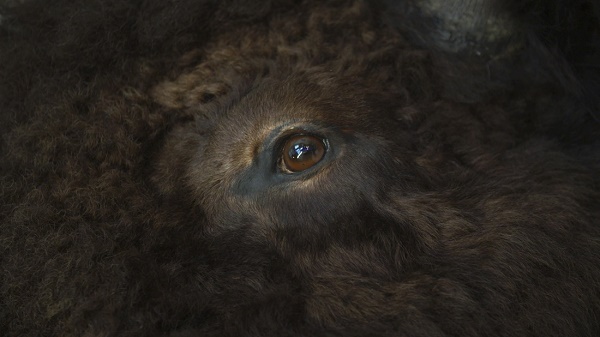
Ali Cherri, Somniculus, 2017
Museums, as objects, are here to tell us about an elsewhere that we don’t know, in order to educate us and provide us with rational, learned, Cartesian discourses —especially ethnographic, archeological and natural history museums. Of course, this is set in a model that structures our society and outlook. The same artifacts won’t relay the same discourse whether they are displayed in a “cabinet of curiosities,” a colonial museum, an antiques shop, a flea market or the Quai Branly museum. Our ideology in showing and exhibiting imposes itself on the artifact and our gaze has to conform to it. Sure, we can choose to be docile, because we are respectful, conformist, and learning; or we can choose to be skeptical and reluctant when faced with, for example, the national narrative of Napoleon III’s Second Empire, the racialist phrenology of colonial exhibitions, or falsified colonizing archeology in Moshe Dayan’s style. However, we always remain within this rational logic, consuming meaning and context.

First, astonishment seizes you: what? a Bernard Buffet exhibition (at the MAMVP, October 14, 2016 – March 5, 2017)? Then, doubt unfurls: maybe I’ve let something slip by me? Am I missing out on some revelation because of my prejudices?
After having seen the exhibition, it’s nothing but consternation: how could they dare to make such an unconvincing show? Or is it that rehabilitating Buffet amounted to an impossible task? And if so, why put together this exhibition? To please Pierre Bergé, the ex-boyfriend, who owns a fair amount of the paintings on display (his portrait pictured last)? I cannot think so. This is not a rediscovery or rehabilitation, this is a “rebranding” —on the walls of the exhibition, a quote from Bergé: “[Buffet’s] prickly signature has become a brand name.” Is this actually the context in which we should apprehend this promotional relaunch?

Philippe Cognée, Solar crowd, 2016, 150x150cm
Greyish, blueish, reddish canvases with muted hues: these are crowds, so we’re told. No border, no frame, what we see is only a fragment of an immensity that we assume stretches left and right, up and down, infinitely expanding, maybe, like photos of clouds. These are crowds of people, individuals lost in the mass, barely discernable. Each person moves, goes forward, makes a gesture; the whole thing is like an idiorhythmy, a community where everyone blends but no one disappears.

Carl Andre, poem, 1982
The Carl Andre exhibition at the MAMVP (October 18, 2016 – February 12, 2017) is a very good retrospective, ranging from his –large-scale or miniature– sculptures to his visual poems (lesser-known works, albeit their formal beauty is truly captivating, beyond meaningfulness). But something is arresting: the gap, probably an unbridgeable one, between the artist’s original intentions and the way his artworks are displayed in museums.
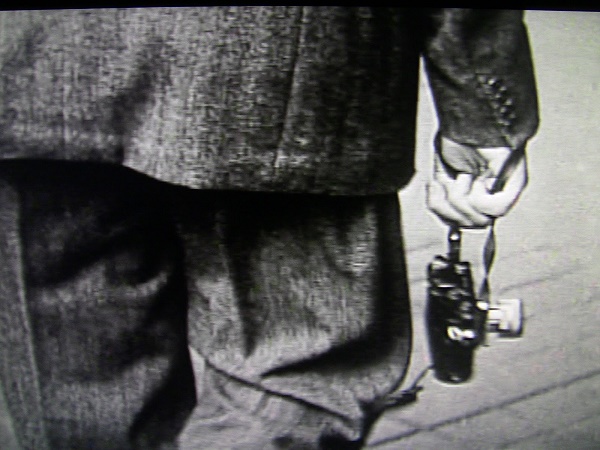
Granted, the exhibition “Images à la Sauvette” at the Fondation Cartier-Bresson (January 11 – April 23, 2017) is a great opportunity to see most of the photographs published in the eponymous –and mythical– album, be it for the first time or once again. Undoubtedly, it will be an interesting discovery for neophytes, and a refresh of pleasant memories for long-time amateurs of Henri Cartier-Bresson’s work. But it seemed there were no surprises, nothing original, until I happened on a short 1’40’’ film, shown in a nook, in which we can see the Frenchman at work (although he apparently hated being photographed of filmed), caught in action by the American photographer Gjon Mili. The scene takes place during the celebrations for the Chinese New Year in New York, in 1959: paper dragons, firecrackers, a crowd… nothing extraordinary, just partying. But in the midst of this crowd, we see a man dancing, jumping, bouncing around in whirls and zigzags, gently elbowing his way, taking a step back, two steps aside, three steps forward, ready for anything.
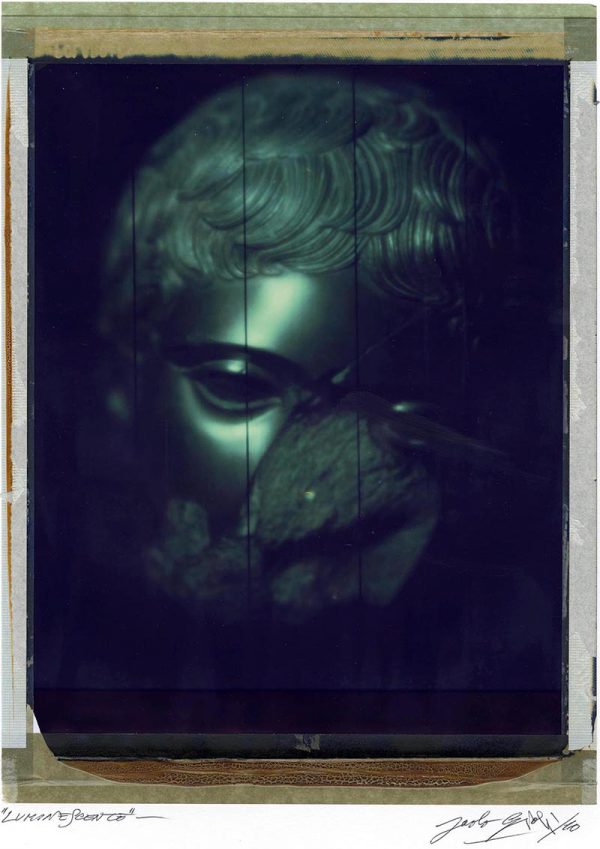
Paolo Gioli, Luminescenti, 2010, polaroid, 20x25cm
Two series of photographs by Paolo Gioli are currently on show at SAGE Paris gallery, until November 6, including these images of ancient sculptures, bathed in a green light that gives them an eerie presence.

Paolo Gioli, Luminescenti, exhibition view, François Sage Gallery
This wall of photographs will be on display at Paris Photo; to find out more about them, you can read the little book in which I wrote on those series – I will sign it at the gallery’s booth (C30) during the fair, Saturday, November 12, 3pm. Come!

Anton Giulio Bragaglia and Arturo Bragaglia, Salutando, 1911, 17.5x23cm, Galleria civica in Modeno
To question the nature of photography is the aim of Pandora’s Box, an exhibition curated by Jan Dibbets at the MAMVP in Paris (a museum the artist is familiar with), from March 25 to July 17, 2016. Hailing from conceptual art, Dibbets was among the first to examine photography itself (alongside William Anastasi, then Michael Snow, John Hilliard, Tim Rautert and Ugo Mulas). Around 1970, he created a series of photographs addressing the processes and mechanisms of photography , as well as its essence, as opposed to the images represented: the “how” of photography rather than its “what.” In this exhibition, Dibbets presses forward with these same concerns, reframing them within the history of photography, and nourishing them with readings of Vilém Flusser’s ideas –a thinker he discovered while preparing the exhibition. (This fact was of great interest to me, of course; it is more thoroughly explained in a video of his interview with Fabrice Hergott than in the catalogue).
Pandora’s Box has been put together by an artist, not an art historian, and therefore there were some liberties taken, some partial choices made, some incongruous selections (especially in the last section, which was quite disappointing), and some bizarre omissions (from the five precursors I just cited, only Anastasi and Snow are featured, and Mulas’ absence in particular is baffling, if it is not simply a petty move by Dibbets). Those choices will appeal or not to the visitor, but –at least until the last section– they make for a compelling exhibition. Continue reading

Seydou Keïta, Untitled, 1956-1957 (printed 1997), 120x180cm [left]; Untitled, 1958 (printed 1997), 120x180cm [right]
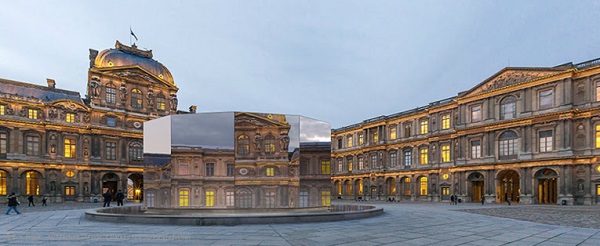
Eva Jospin, Panorama
The initial shock of Eva Jospin’s installation in the Louvre’s Cour Carrée (April 12 – August 28, 2016) comes from its display. To discover its high reliefs, the visitor has to pass through several consecutive concentric enclosures to reach the center. First, the classical buildings of the Cour Carrée; next, a circular basin made of stone containing stagnant greenish water; then, set in this basin, a decagonal pavilion reflecting the Louvre facade on its walls – echo and mirror. (The glass Pyramid is not visible because of the obtuse angle towards it; obfuscating the Pyramid – another “grafted” structure – is definitely not fortuitous.) Continue reading